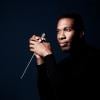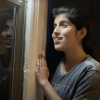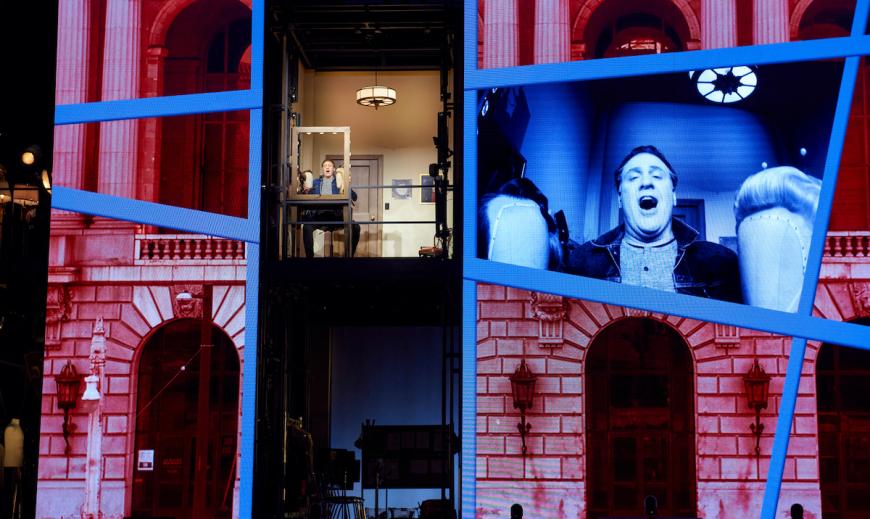
Live opera again, at last! After more than a year of Zoom substitutes, we were treated last weekend to something more like the real thing at SF Opera’s first venture back to the stage, a clever adaptation of Rossini’s brilliant Barber of Seville: High-quality professional singers performing together in real time with an actual orchestra and conductor; a production team full of comedic inventiveness and technical workarounds; and an audience actually watching and listening to it all, together at last.
With the pandemic finally loosening its grip on Bay Area cultural life, but still very much with us, this had to be opera with a difference. Most prominently, the opera took a hike from its usual venue, the War Memorial Opera House, north across the bridge to the parking lots of Marin Center, on a vast rock-event- style outdoor stage, open to the infection-dispelling breezes. The orchestra, conducted by Roderick Cox, was housed in a tent at the back. Social distancing protocols meant that the singers, unmasked, stayed at least six feet apart. The audience listened in their cars, windows closed for the most part.
The complicated logistics were admirably planned and accomplished by SF Opera staff and (I presume) Marin Center security and staff — access and protocols were made clear in advance and on arrival, and we were greeted with a party bag with glowsticks, masks, and instructions on access to the digital program and the radio broadcast of the music.
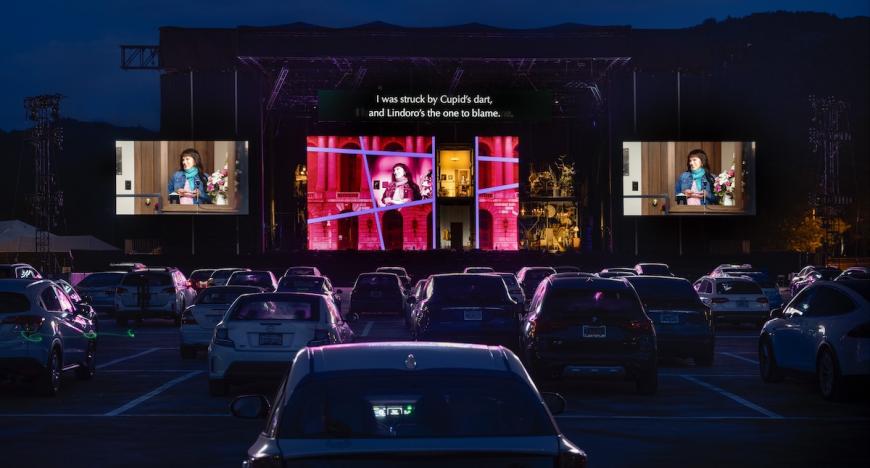
Sensibly, director Matthew Ozawa shortened Barber to about 100 minutes — intermission snacks and chat not yet being feasible — in a rework involving backstage antics and a deft English translation by Marcie Stapp. Some arias were presented as warm-up exercises and some simply as one-offs, only slightly integrated into the storyline. Ensembles were mostly presented as rehearsals, including a hilarious rendition of the Act I duet between Figaro and Almaviva, involving overscrupulous social distancing. By the end, somewhat implausibly, the action devolved to an “actual” performance on the (virtually projected) War Memorial main stage.
The massive set, partly recycled from SF Opera’s pandemic-canceled Fidelio, was an active participant in the action, featuring a two-story depiction of the opera’s home auditorium, and piquing opera-goers with glimpses of backstage, including random props from previous SF Opera productions and recreations of War Memorial dressing rooms, complete with mirrors and photos of past stars. Set and projection designer Alexander V. Nichols and his team must have had a field day putting all that together.
The visual experience was vividly engineered, with brilliant videography making the most of a multitude of cameras and points of view on a number of massive LED screens. The comedic action, full of sight gags, was presumably visible even to cars parked far from the stage. But that reliance on video comes with a cost. The effect, for me at least, was a disconnect between the intimacy of some of the close-ups and the sensory strain of maintaining an overall grasp of the multiple video windows—not to mention, my own car windshield.
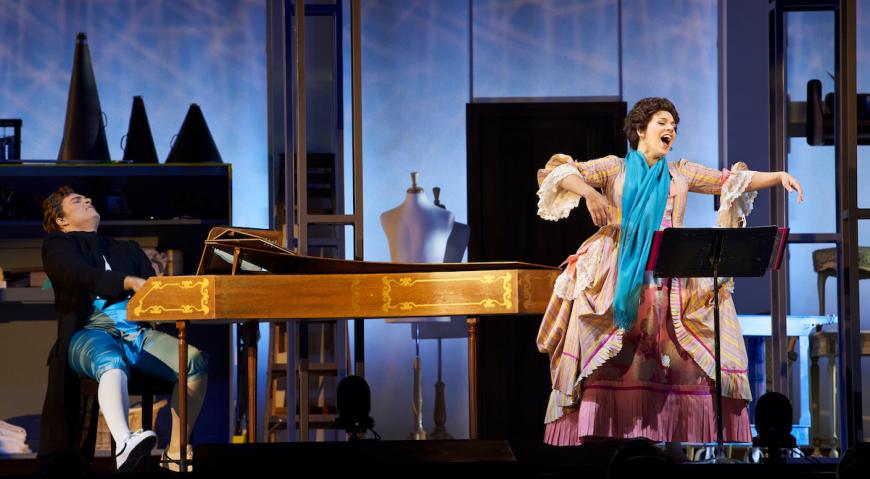
The bulk of the singing was carried by the four principals. Philip Skinner was a gruff and sputtery Don Bartolo, ready prey for Lucas Meacham’s brash Figaro. The romantic leads, Rosina and Almaviva, were sung by real-life couple Daniela Mack and Alek Shrader; it was a curious twist to have a very pregnant Rosina feature in a 19th-century courtship drama. Mack’s ingenue was quite as feisty as her accomplice Figaro, and she nimbly executed the role’s intricate ornamentations. Shrader brought both humor and passion to Almaviva, especially in his scenes with Mack. Kenneth Kellogg sang a truncated role for Don Basilio; as Berta, Catherine Cook was convincing in her aria about love in old age. Will Bryan as “Officer” manfully attempted to maintain some order in the confusions and deceptions — only to concede in the end to hegemonic privilege in the person of Count Almaviva.
Isolated in our own bubbles, the audience had limited ways to interact with the performance, but rock-concert-style glowsticks, a few “bravos,” and a deal of horn-honking at the curtain call gave a sense of appreciation and helped to build the sense that we were again at live opera. A convertible near me sported eager young opera fans in flamboyant “Rossini” costumes.
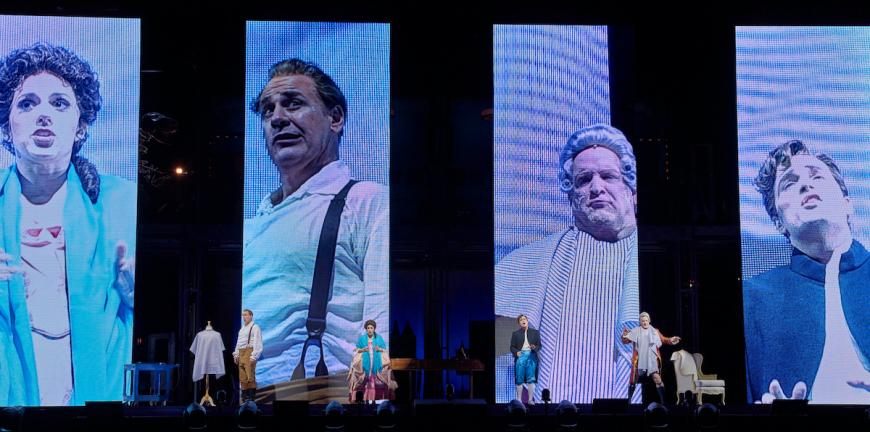
The evening was welcome both as a diversion from isolation and a glimmer of hope — both to the audience and, one imagines, to the company and its artists, who at last may sense a return to an active and sustainable life of rehearsal and performance. But to me, the communal experience of stage and music that is opera-going still feels far away. In many ways, because of the ongoing effects of necessary pandemic precautions, the production had to be a simulacrum rather than a reality — a kind of ghost experience.
In particular, it was because of the intrusive hand of electronic mediation, that subtle invasive, alienating delay that has left so many of us “Zoomed out.” This was evident in the way we saw the opera — mostly on screen — but even more so in how we heard it. The music was —had to be — electronically mediated, heard only through car radios in our acoustically dead automotive bubbles. Perhaps more importantly, the singers themselves had to engage each other primarily through earbuds with wireless connections. As a result, the ogre of latency was inevitably in fine fettle. As anyone who has been performing, teaching, or even chatting online knows well, even millisecond delays, compounded by iteration, affect the result seriously.
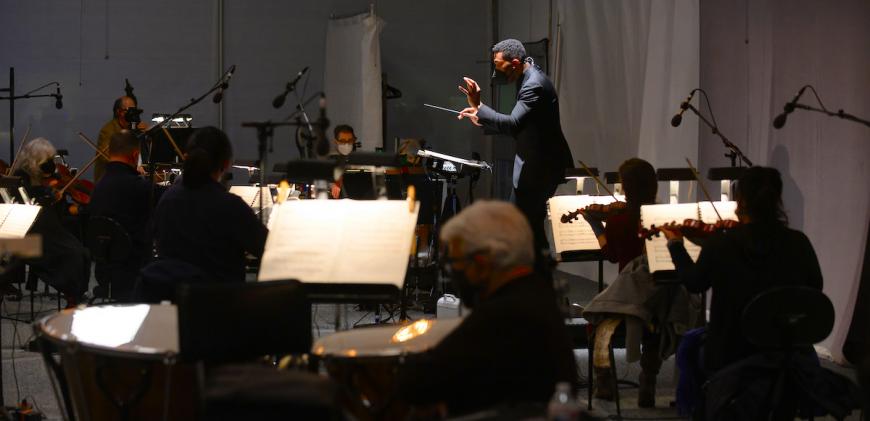
Rossini’s sparkling, agile music — the perfect material for a first return to live opera — suffers particularly from the delays of latency. Ensemble numbers lose that tightness that one would expect in an opera house, where singers could actually stand near each other and hear each other’s voices reflected in the acoustics of a real building. In the complex septet that ends Act I, for example, even with actors on the same stage, each singer’s sense of the pulse was slightly, but noticeably, out of kilter with each other and with the orchestra. Most successful were the solo arias where coordination with other singers was not an issue.
Rossini’s sparkle in part comes from brisk tempos, allowing orchestra and singers alike to show off with patter-song virtuosity and lithe ornamentation. But latency has an effect on tempo as well as ensemble, as each tiny delay can accumulate, and this seemed in evidence in this production. Singing in English, with its taxing load of consonants, made this even more difficult.
As always throughout this difficult year, we soldier on in hope of a full return. This Barber is accomplished with so much inventiveness, hard work, and skill that despite these shortcomings, it is a welcome entertainment and a promise of a renewed future for live opera.



